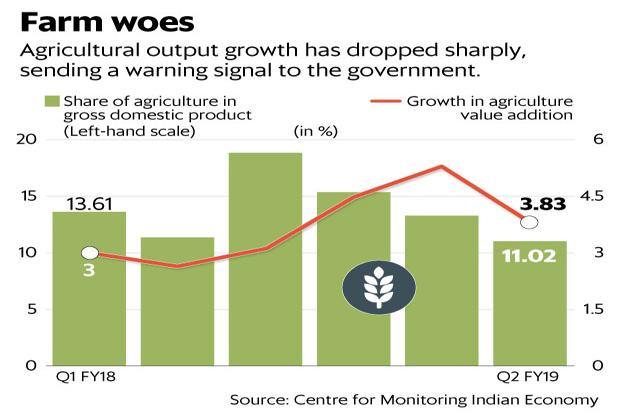Skip to content

Relevant For Sociology, GS & Essay:-

- India’s gross domestic product (GDP) growth for the second quarter (Q2) has laid bare the deepening distress in its villages. Farm incomes haven’t risen even though the government has announced a hike in minimum support prices. The country’s agricultural output, measured as gross value added, grew at a sedate pace of 2.8%, far slower than the 5.3% in the June quarter. This was on top of a low base of 2.6% growth last year.
- Economists said that the GDP deflator for agriculture is negative for the first time in many years. In other words, farmers are earning less than what they were before. Indeed, if the recent marches to New Delhi by thousands of farmers are any indication, the farm sector has already sent up emergency flares.
- What is notable is that even allied activities are growing slower. This doesn’t bode well for rural demand in the coming months.
- For a government that will face the litmus test of its policies through a national election within six months, the farm sector’s woes are unsettling. Although agriculture contributes less than one-third of the output of the entire economy, rural centres are key demand areas. Consumption demand from the rural economy also needs to hold up for the overall growth rate to remain above 7%.
- An extension of the troubles of the Indian economy has also been visible on the expenditure side. Private final consumption expenditure grew by 7%, which was lower than the 8.6% in the previous quarter. Consumption has been the strongest engine of growth and, incipient signs of a slowdown that was followed by distress in the financial sector, will hurt the economy.
- To balance this gloom was a bright spark in gross fixed capital formation. This grew at a brisk pace of 12.5%, but on a low base of 6.1% a year ago. Gross fixed capital formation has been growing faster and faster every quarter over the last five years, which is a sign of traction in investment growth. Juxtaposing the not-so-bad 7.4% growth in manufacturing gives hope on the employment front.
- That said, economists believe the latest growth numbers dash hopes of the estimated 7.4% GDP growth for the full year of 2018-19. The urge to let loose a fiscal stimulus ahead of elections is high, especially to alleviate the pain in agriculture. But can the government afford to give in to such an urge?
- Even as the debate over revising past GDP growth rates continues, the government and the markets should be really worried about the impact of rural distress on the pace and direction of economic growth.


